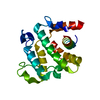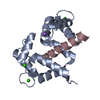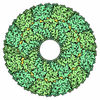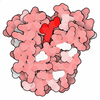[English] 日本語
 Yorodumi
Yorodumi- PDB-2lgf: Solution structure of Ca2+/calmodulin complexed with a peptide re... -
+ Open data
Open data
- Basic information
Basic information
| Entry | Database: PDB / ID: 2lgf | ||||||
|---|---|---|---|---|---|---|---|
| Title | Solution structure of Ca2+/calmodulin complexed with a peptide representing the calmodulin-binding domain of L-selectin | ||||||
 Components Components |
| ||||||
 Keywords Keywords | METAL BINDING PROTEIN | ||||||
| Function / homology |  Function and homology information Function and homology informationglycosphingolipid binding / sialic acid binding / oligosaccharide binding / : / : / : / : / : / positive regulation of protein autophosphorylation / calcium-dependent cell-cell adhesion ...glycosphingolipid binding / sialic acid binding / oligosaccharide binding / : / : / : / : / : / positive regulation of protein autophosphorylation / calcium-dependent cell-cell adhesion / negative regulation of peptidyl-threonine phosphorylation / leukocyte tethering or rolling / establishment of protein localization to mitochondrial membrane / type 3 metabotropic glutamate receptor binding / CaM pathway / positive regulation of peptidyl-threonine phosphorylation / Cam-PDE 1 activation / heterophilic cell-cell adhesion / Sodium/Calcium exchangers / Calmodulin induced events / Reduction of cytosolic Ca++ levels / positive regulation of DNA binding / Activation of Ca-permeable Kainate Receptor / CREB1 phosphorylation through the activation of CaMKII/CaMKK/CaMKIV cascasde / Loss of phosphorylation of MECP2 at T308 / CREB1 phosphorylation through the activation of Adenylate Cyclase / response to corticosterone / CaMK IV-mediated phosphorylation of CREB / PKA activation / negative regulation of high voltage-gated calcium channel activity / leukocyte cell-cell adhesion / Glycogen breakdown (glycogenolysis) / CLEC7A (Dectin-1) induces NFAT activation / Activation of RAC1 downstream of NMDARs / negative regulation of ryanodine-sensitive calcium-release channel activity / organelle localization by membrane tethering / mitochondrion-endoplasmic reticulum membrane tethering / autophagosome membrane docking / negative regulation of calcium ion export across plasma membrane / regulation of cardiac muscle cell action potential / presynaptic endocytosis / Synthesis of IP3 and IP4 in the cytosol / nitric-oxide synthase binding / regulation of cell communication by electrical coupling involved in cardiac conduction / regulation of synaptic vesicle exocytosis / Phase 0 - rapid depolarisation / calcineurin-mediated signaling / Negative regulation of NMDA receptor-mediated neuronal transmission / Unblocking of NMDA receptors, glutamate binding and activation / RHO GTPases activate PAKs / Uptake and function of anthrax toxins / Ion transport by P-type ATPases / adenylate cyclase binding / regulation of ryanodine-sensitive calcium-release channel activity / Long-term potentiation / protein phosphatase activator activity / Calcineurin activates NFAT / Regulation of MECP2 expression and activity / positive regulation of protein serine/threonine kinase activity / DARPP-32 events / Smooth Muscle Contraction / detection of calcium ion / regulation of synaptic vesicle endocytosis / regulation of cardiac muscle contraction / catalytic complex / RHO GTPases activate IQGAPs / regulation of cardiac muscle contraction by regulation of the release of sequestered calcium ion / activation of adenylate cyclase activity / cellular response to interferon-beta / phosphatidylinositol 3-kinase binding / calcium channel inhibitor activity / Activation of AMPK downstream of NMDARs / Protein methylation / presynaptic cytosol / positive regulation of nitric-oxide synthase activity / regulation of release of sequestered calcium ion into cytosol by sarcoplasmic reticulum / Ion homeostasis / enzyme regulator activity / eNOS activation / titin binding / Tetrahydrobiopterin (BH4) synthesis, recycling, salvage and regulation / sperm midpiece / regulation of calcium-mediated signaling / response to cytokine / voltage-gated potassium channel complex / calcium channel complex / FCERI mediated Ca+2 mobilization / substantia nigra development / regulation of heart rate / Ras activation upon Ca2+ influx through NMDA receptor / FCGR3A-mediated IL10 synthesis / Antigen activates B Cell Receptor (BCR) leading to generation of second messengers / secretory granule membrane / response to amphetamine / calyx of Held / adenylate cyclase activator activity / sarcomere / VEGFR2 mediated cell proliferation / protein serine/threonine kinase activator activity / nitric-oxide synthase regulator activity Similarity search - Function | ||||||
| Biological species |  Homo sapiens (human) Homo sapiens (human) | ||||||
| Method | SOLUTION NMR / torsion angle dynamics, simulated annealing | ||||||
| Model details | lowest energy, model 1 | ||||||
 Authors Authors | Gifford, J.L. / Ishida, H. / Vogel, H.J. | ||||||
 Citation Citation |  Journal: J.Biol.Chem. / Year: 2012 Journal: J.Biol.Chem. / Year: 2012Title: Structural Insights into Calmodulin-regulated L-selectin Ectodomain Shedding. Authors: Gifford, J.L. / Ishida, H. / Vogel, H.J. | ||||||
| History |
|
- Structure visualization
Structure visualization
| Structure viewer | Molecule:  Molmil Molmil Jmol/JSmol Jmol/JSmol |
|---|
- Downloads & links
Downloads & links
- Download
Download
| PDBx/mmCIF format |  2lgf.cif.gz 2lgf.cif.gz | 64.5 KB | Display |  PDBx/mmCIF format PDBx/mmCIF format |
|---|---|---|---|---|
| PDB format |  pdb2lgf.ent.gz pdb2lgf.ent.gz | 46.5 KB | Display |  PDB format PDB format |
| PDBx/mmJSON format |  2lgf.json.gz 2lgf.json.gz | Tree view |  PDBx/mmJSON format PDBx/mmJSON format | |
| Others |  Other downloads Other downloads |
-Validation report
| Summary document |  2lgf_validation.pdf.gz 2lgf_validation.pdf.gz | 500.9 KB | Display |  wwPDB validaton report wwPDB validaton report |
|---|---|---|---|---|
| Full document |  2lgf_full_validation.pdf.gz 2lgf_full_validation.pdf.gz | 540.1 KB | Display | |
| Data in XML |  2lgf_validation.xml.gz 2lgf_validation.xml.gz | 14 KB | Display | |
| Data in CIF |  2lgf_validation.cif.gz 2lgf_validation.cif.gz | 12.9 KB | Display | |
| Arichive directory |  https://data.pdbj.org/pub/pdb/validation_reports/lg/2lgf https://data.pdbj.org/pub/pdb/validation_reports/lg/2lgf ftp://data.pdbj.org/pub/pdb/validation_reports/lg/2lgf ftp://data.pdbj.org/pub/pdb/validation_reports/lg/2lgf | HTTPS FTP |
-Related structure data
| Similar structure data | |
|---|---|
| Other databases |
- Links
Links
- Assembly
Assembly
| Deposited unit | 
| |||||||||
|---|---|---|---|---|---|---|---|---|---|---|
| 1 |
| |||||||||
| NMR ensembles |
|
- Components
Components
| #1: Protein | Mass: 16650.273 Da / Num. of mol.: 1 / Fragment: sequence database residues 4-149 Source method: isolated from a genetically manipulated source Source: (gene. exp.)  Homo sapiens (human) Homo sapiens (human)Gene: CALM1, CALM, CAM, CAM1, CALM2, CAM2, CAMB, CALM3, CALML2, CAM3, CAMC, CAMIII Production host:  |
|---|---|
| #2: Protein/peptide | Mass: 1834.344 Da / Num. of mol.: 1 / Fragment: sequence database residues 349-363 / Source method: obtained synthetically / Source: (synth.)  Homo sapiens (human) / References: UniProt: P14151 Homo sapiens (human) / References: UniProt: P14151 |
| #3: Chemical | ChemComp-CA / |
-Experimental details
-Experiment
| Experiment | Method: SOLUTION NMR | ||||||||||||||||||||||||||||||||||||||||||||||||||||||||||||||||||||
|---|---|---|---|---|---|---|---|---|---|---|---|---|---|---|---|---|---|---|---|---|---|---|---|---|---|---|---|---|---|---|---|---|---|---|---|---|---|---|---|---|---|---|---|---|---|---|---|---|---|---|---|---|---|---|---|---|---|---|---|---|---|---|---|---|---|---|---|---|---|
| NMR experiment |
|
- Sample preparation
Sample preparation
| Details |
| ||||||||||||||||||||||||||||||||||||||||||||||||||||||||||||||||||||||||||||||||||||||||||||||||||||||||||||||||||||||||||||||||||||||||||||||||||||||||||||||||||||||||||||||||||||||||||||||||||||||||||||||||||||||||||||||
|---|---|---|---|---|---|---|---|---|---|---|---|---|---|---|---|---|---|---|---|---|---|---|---|---|---|---|---|---|---|---|---|---|---|---|---|---|---|---|---|---|---|---|---|---|---|---|---|---|---|---|---|---|---|---|---|---|---|---|---|---|---|---|---|---|---|---|---|---|---|---|---|---|---|---|---|---|---|---|---|---|---|---|---|---|---|---|---|---|---|---|---|---|---|---|---|---|---|---|---|---|---|---|---|---|---|---|---|---|---|---|---|---|---|---|---|---|---|---|---|---|---|---|---|---|---|---|---|---|---|---|---|---|---|---|---|---|---|---|---|---|---|---|---|---|---|---|---|---|---|---|---|---|---|---|---|---|---|---|---|---|---|---|---|---|---|---|---|---|---|---|---|---|---|---|---|---|---|---|---|---|---|---|---|---|---|---|---|---|---|---|---|---|---|---|---|---|---|---|---|---|---|---|---|---|---|---|---|---|---|---|---|---|---|---|---|---|---|---|---|---|---|---|---|
| Sample |
| ||||||||||||||||||||||||||||||||||||||||||||||||||||||||||||||||||||||||||||||||||||||||||||||||||||||||||||||||||||||||||||||||||||||||||||||||||||||||||||||||||||||||||||||||||||||||||||||||||||||||||||||||||||||||||||||
| Sample conditions |
|
-NMR measurement
| NMR spectrometer | Type: Bruker Avance / Manufacturer: Bruker / Model: AVANCE / Field strength: 500 MHz |
|---|
- Processing
Processing
| NMR software |
| |||||||||||||||||||||||||||||||||||||||
|---|---|---|---|---|---|---|---|---|---|---|---|---|---|---|---|---|---|---|---|---|---|---|---|---|---|---|---|---|---|---|---|---|---|---|---|---|---|---|---|---|
| Refinement | Method: torsion angle dynamics, simulated annealing / Software ordinal: 1 | |||||||||||||||||||||||||||||||||||||||
| NMR representative | Selection criteria: lowest energy | |||||||||||||||||||||||||||||||||||||||
| NMR ensemble | Conformer selection criteria: structures with the lowest energy Conformers calculated total number: 200 / Conformers submitted total number: 1 |
 Movie
Movie Controller
Controller












 PDBj
PDBj































 HSQC
HSQC